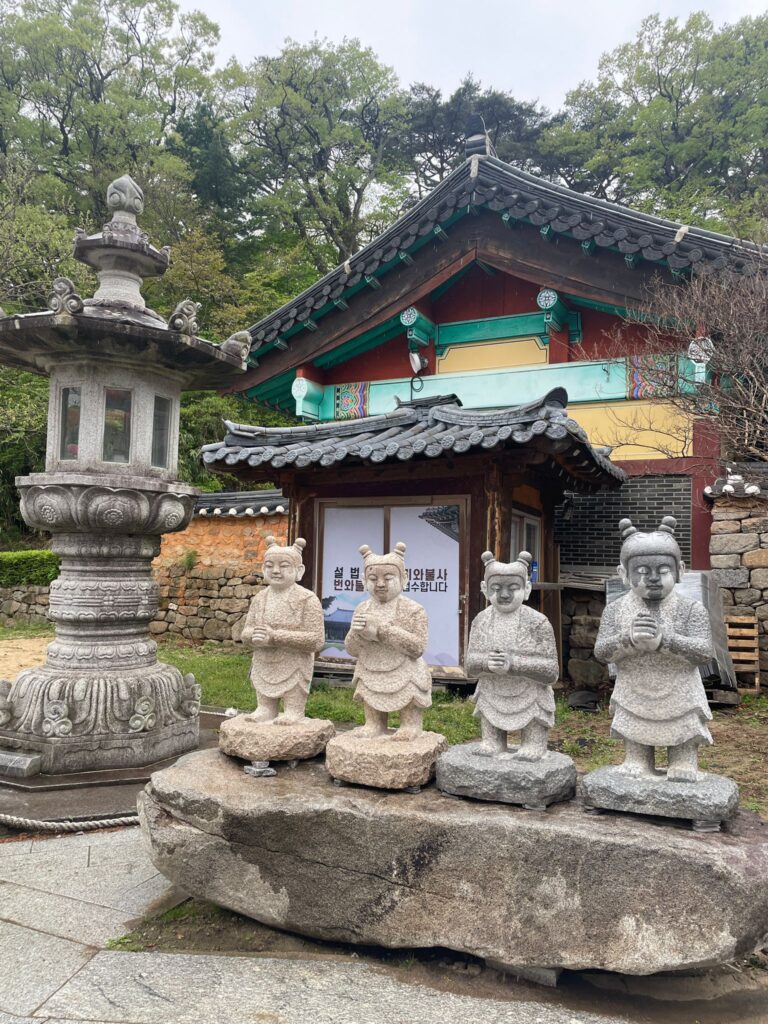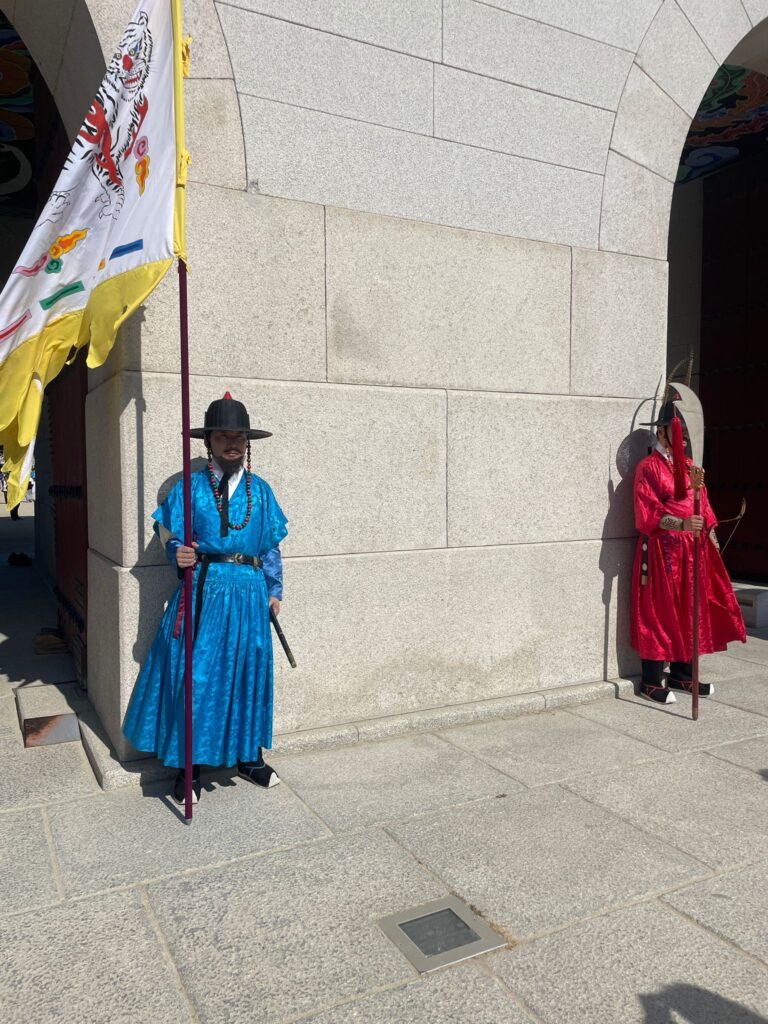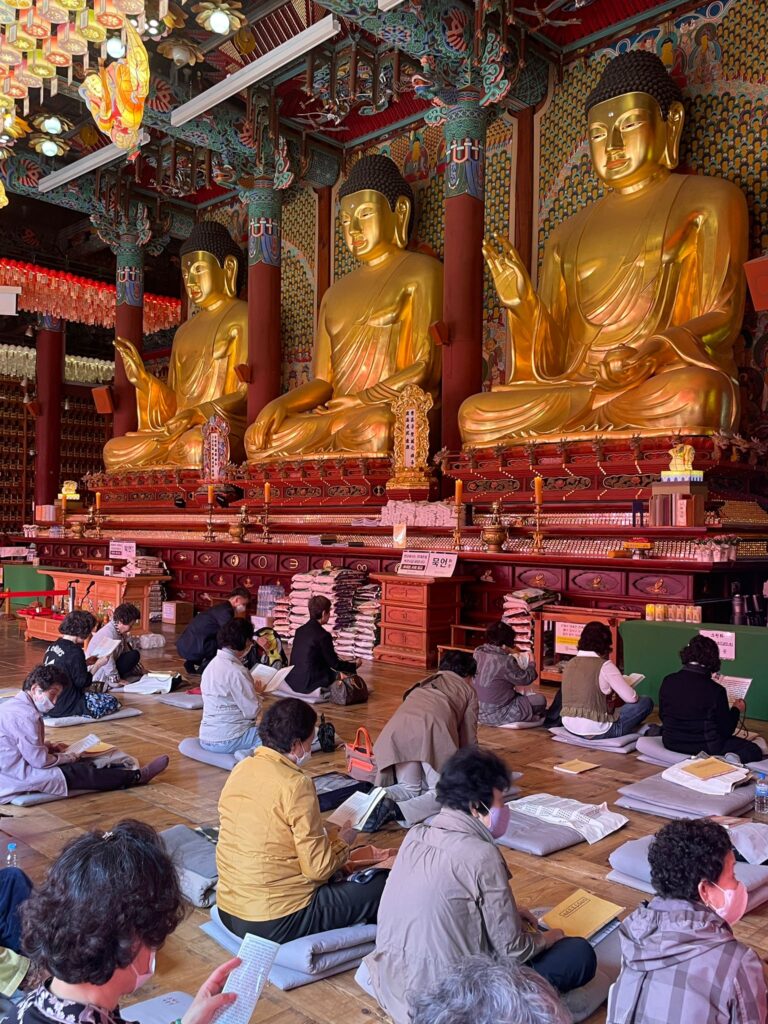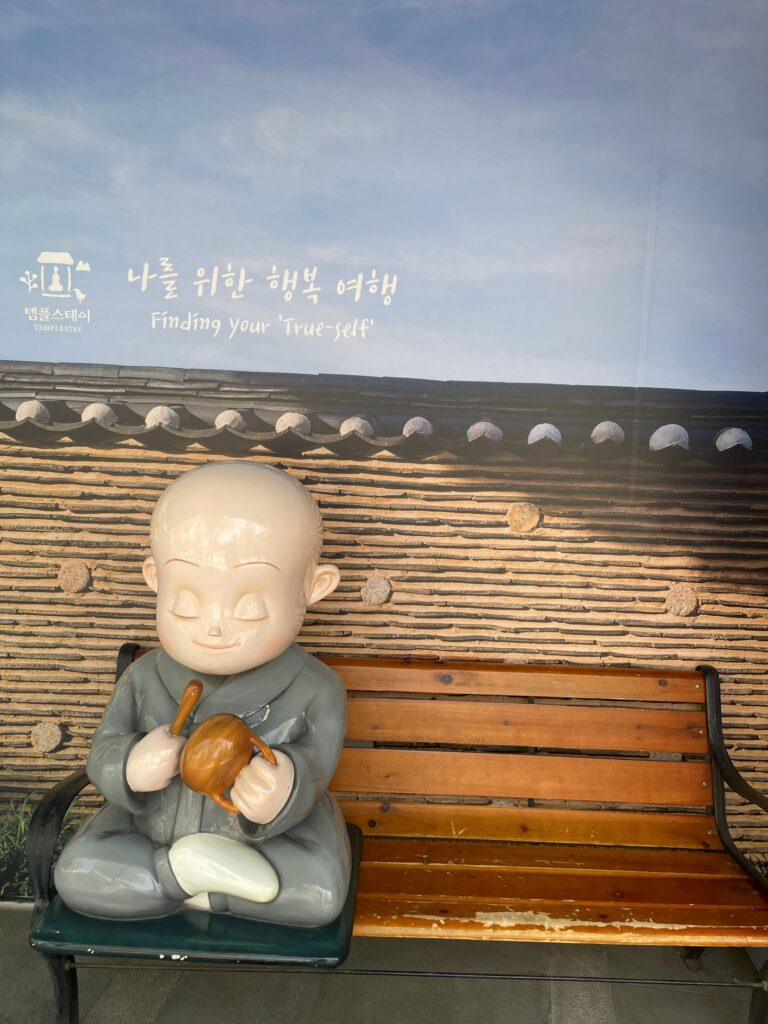An Expat’s Guide to Solo Travel in South Korea
Disclaimer: Some links on this page may be affiliate links. If you purchase anything through them, I will receive a small commission at no extra cost to you! Further details in the Privacy Policy.
If you’re looking for tips on solo travel in South Korea, I will share everything you need to know here.
I lived in South Korea from August 2023 working as an English teacher on a year-long contract and have taken many solo trips around the country since then. I’ve learnt everything you need to know about safety, logistics and navigating what can be a challenging country if you don’t speak Korean.
So allow me to share everything I know here.

Is Korea Safe to Travel to Alone?
Yes. South Korea is one of the safest countries in the world in terms of crime. It ranks 16th on the Numbeo Crime Index behind several countries famous for their high safety rates including Japan, Iceland, Singapore (which is the safest Southeast Asian country) and several Middle Eastern countries.
Safe countries generally follow two main trends. They have ultra strict laws with harsh punishments for criminals, and they are often rich countries with little poverty.
South Korea also has a strong politeness and respect culture going on.
If you leave your phone or laptop unattended in a public place, it will still be there a few hours later. I saw a man leave his laptop behind in a coffee shop and come back for it a while later. South Korea is not Western Europe, so you don’t need to worry about theft here.
The only area in which Korea falls short on crime is in the workplace. There are many dodgy activities taking place in workplaces, something I wish I’d known before teaching in Korea.
However as a tourist, this won’t have any impact on you, and this country is ultra safe for solo travel.
Best Time to Visit South Korea
The best time to visit South Korea is in April when you have a combination of lovely warm weather and the famous cherry blossom season.
Avoid July-August (uncomfortably hot and the very wet monsoon season). Also avoid winter time (December-February) as it is freezing cold and not pleasant out here.
I wrote a detailed guide on the best time to visit South Korea, which you can read for more details and to find out the monthly temperatures in the country’s main tourist spots.

Is Transport Easy to Use in South Korea?
Transport Between Cities
Solo travel in South Korea is usually easy. Although it doesn’t always go smoothly. I was once kicked off a bus because “it was full”.
That seems reasonable, until you realise I was around 5th in the queue (of around 11) to get on the bus, and everyone else (all Koreans) was allowed on, but not the solo foreigner…
And yes I had a valid ticket.
Anyway, that story is my only solo travel nightmare in Korea. The transport has otherwise gone very smoothly. Oh, and it’s nearly always on time. Nearly…
By Bus
Getting between major cities in Korea is (usually) pretty easy. Head to the main bus station and you will find several ticket machines.
Often, these ticket machines have an English option. This will make it easy to choose where you want to go to.
Tickets for 2-4 hour journeys generally cost no more than around ₩21,000 (£12/US$15) for a one-way journey between any two major cities or towns with a bus station.
Annoyingly, these machines usually only let you purchase one-way tickets. Some will allow you to book a return ticket in a separate transaction, but this isn’t always the case. Often you won’t be able to buy the return ticket until you reach your destination. Then you need to hope they haven’t sold out, and the bus times work for you.
I have encountered machines with no English language option. One example of this was in Daegu at SeoBu Bus Terminal. It took the Google Lens feature of Google Translate to work out what I needed to do to find my way back to my home city from here.
The staff at SeoBu Bus Terminal spoke no English, meaning I relied solely on my phone to translate.
Oh, and sometimes the translations can be dodgy. On one occasion I went to Songnisan to visit Beopjusa Temple and the English translation listed it as Sokrisan on the machine. Fortunately the guy at the information desk spoke enough English to explain this to me.
By Train
Trains connect Seoul with Busan and a handful of other cities across the centre and south of the country. The main arteries head down to Gwangju, Mokpo, Yeosu-Expo and cover the likes of Daejeon, Dongdaegu and Seodaejeon.
There are no trains in northeastern South Korea. In fact here is a map showing all the Korean train routes as of 2025.
Tickets cost a lot more than bus tickets. The popular Seoul to Busan route costs over ₩50,000 (£28/US$35) for a one-way ticket. It can take up to 6 hours to arrive if you purchase one of the cheaper tickets. The more expensive options can get you a 2.5 hour journey instead.
Transport Within Cities
Public transportation within cities is very cheap and very easy to use once you get the hang of it.
By Bus
To use the bus within a city, simply step onboard and put your money in the tray. Be quick though, Korean culture is very fast-paced and if you don’t put that cash down within a few seconds then the driver will wave you on and you will have to come back to the front of a moving bus to pay.
Bus journeys are very cheap within cities, rarely costing more than around ₩2,500 (£1.50/US$1.75) for a one-way ticket.
By Metro
Metros exist in Seoul (and Incheon, with the two metros crossing paths at Seongnam Station), Busan, Daegu, Daejeon and Gwangju.
Tickets are again very cheap. They cost a rough average of ₩1,500-2,000 (£0.90/US$1.05-£1.20/US$1.40) per journey.
I found the Seoul metro a little confusing at first. But it’s pretty easy once you get the hang of it. You hit the English translation button on the screen (if necessary), select your destination and number of tickets, then put money in.
Korean culture isn’t known for patience. As with local buses you have little time here. Expect to hit the “extend timer” button several times before you finish your transaction. Otherwise you’ll have to start again.
Uber or Kakao T (Kakao Taxi)
Now Uber does operate in South Korea, and in quite a few cities, but there is no Uber in popular Busan or on Jeju Island. However… it still works in these cities.
This is because you can book a Kakao T taxi through the Uber app. If you’re wondering what Kakao T is, it is South Korea’s main rideshare app.
Kakao T operates across much of the country and it’s easy to use. You can choose to pay for rides in cash, which is the easiest option as a tourist really.
I’d advise having both apps on your phone, so you can choose the cheapest option when necessary.

What to Pack for Korea?
Fortunately South Korea isn’t a country where you really need to bring anything extra that you wouldn’t need in Europe or the USA.
Mosquitos are pesky, but you don’t need a mosquito net or malaria tablets here. They only come out in the summer, and sure they’re annoying, but they rarely carry deadly diseases such as Malaria, at least in urban areas. Although a small handful of cases have been reported in rural areas including the DMZ which is worth visiting on your Korea trip.
As for the weather, just pack appropriate clothes for the season. Jackets, gloves, scarves and hats are necessary in the winter, whereas summer calls for a t-shirt and shorts.
Hiking boots are a smart idea if you plan on going to the mountains, but only really if you’re into actually hiking rather than sightseeing. I went to some Buddhist temples in the mountains such as Beopjusa Temple and Donghwasa Temple. Neither of those required anything other than normal everyday footwear.
Korea uses the same plug sockets you will find in most of mainland Europe. Therefore an adapter that works in Europe will be necessary out here. I use a Jyomix adapter which has travelled to around 60 countries since January 2019 and works magnificently. It’s one of the best things I’ve ever bought and I’d highly recommend it.
Pretty much everything else needed here would be necessary regardless of whether you’re off to France, the USA or South Korea. I would say a portable charger is particularly important, to make sure you always have access to apps (most importantly, translation and maps) when you’re out and about.
Which Map Apps Work in South Korea?
Now this is one area you may find a few issues with whilst travelling solo in South Korea. If you’re reliant on Google Maps, then I have bad news for you. It doesn’t work well in South Korea.
In fact most useful apps have limited usage here, with a Korean alternative coming out on top.
The apps you need out here are Naver Maps and Kakao Maps. I prefer Naver as it provides clear routes with all transport connections and timings if you are trying to get from A to B.
This isn’t the case with Google Maps in Korea, so I would strongly recommend downloading Naver before coming here.
Naver isn’t without flaws. It doesn’t work offline which is annoying (nor does Google Maps unfortunately, unlike in most countries). It doesn’t always understand English translations either. Sometimes your search for a destination will not work or point you towards the wrong location.
How to Navigate Language Barriers
Communicating with people can be tricky if you don’t speak Korean, particularly outside the main tourist spots.
Sure, you won’t have many issues in Seoul if you only speak English. But outside of the capital, things get a little more tricky.
The Korean alphabet (hangul) can be tough to wrap your head around. After all, it’s not as easy to copy into Google Translate as other Latin languages such as French, Spanish or Italian.
Google Lens has its uses in vaguely translating hangul. But Google Translate isn’t very good in Korea and can come up with some nonsensical translations.
There is a popular Korean translation app called Papago, which is used widely by locals. Unfortunately this is only marginally better than Google Translate and will still give you a load of twaddle half the time.
Having said that, Papago should be your go-to when translating anything in Korean. It’s the best of a bad bunch out here.
Without apps, try using a handful of keywords in English and hopefully locals will be able to pick up on what you’re saying. For example if you’re trying to get to Busan on the 10:30am bus (made up for this example) and the staff at the station don’t speak English, try saying “ten thirty Busan” and that may be enough for them to be able to assist.
Korea is hard to navigate if you don’t speak the language. If you stick to Seoul, Busan and Jeju however then you shouldn’t experience too many issues on your trip.

Do I Need a SIM Card in Korea?
Annoyingly, South Korea is one of the most expensive countries in the world for mobile data. Even as an expat I was reluctant to buy one, due to the cost.
After a few months I caved due to needing one for a few things that only apply to expats and not tourists, therefore I won’t go into detail here.
I went with Woori who offer cheap SIM cards. For tourists they have five options available.
Since I first wrote this post in April 2024, Woori have drastically improved their offering with SIMs available for 5-30 days with unlimited data. They cost from ₩15,000 (£8/US$10) to ₩30,000 (£17/US$21).
South Korea isn’t a country where you need a lot of data. And if you stick to Seoul then you can easily make do without a SIM card. However these packages will be enough to help you access Naver Maps and navigate if you want to see more of the country.
As I say, Google Translate isn’t the best app here. But it does still have its uses, and I would recommend using Google Translate offline in order to save on data.
What do I Need to Know About Money in Korea?
The South Korean currency is called the won, and around 1,800 won are equal to £1 whilst nearer 1,400 won is worth around US$1.
Debit and credit cards work in most places out here. I’d recommend using a travel-friendly card such as Monzo to minimise being stung by fees.
You will need some cash for inner-city transport. Your credit card will not work on local buses and most metro systems.
There is a money card called the Tmoney Card which can get you discounts on transport and attractions. Here is an article on the benefits of the Tmoney Card.
Where Should I go if I Need Something?
South Korea is a country of convenience. You will never be far from a shop selling exactly what you need. Here are the main stores to look out for:
Lotte Mart is a major supermarket chain. If you need any kind of food then you will find it there. Not to be confused with Lotte World (theme park), Lotte Tower and other businesses operating under the Lotte banner. It is the Korean equivalent of Sainsburys, Walmart or any other major supermarket chain you may be familiar with.
For anything which may be described as “household goods” you will need to go to Daiso. This budget store has just about anything you will need which isn’t found in Lotte Mart (and some Lotte Mart stores even have a Daiso inside). If you stay in Airbnb-type accommodation where you cook your own food and do your own cleaning, then Daiso is invaluable.
East Asian countries like Taiwan and Japan love convenience stores, and with 55,000 across the country, Korea can also add its name to that list. You won’t go more than a minute in a major city without seeing GS25, emart24, CU or my personal favourite 7-Eleven. Convenience stores are perfect for quick snacks or a drink on the go. They are very cheap which helps explain their popularity, and going in one is one way to experience Korean culture.
Is There Anything Else I Should Know Before Visiting South Korea?
There are a few travel tips I should share with you related to the culture out here.
Firstly, there are no rubbish bins in public places. It’s bizarre as the streets are super clean, but bins are nowhere to be seen. You have to take your rubbish back with you. Must admit I’ve slipped into a Mcdonalds on a handful of occasions just to use the bins.
Secondly, jaywalking is illegal. You can be fined for crossing the road without doing so at a crossing point. If there are traffic lights, it is illegal to cross unless they are green.
Very annoying since traffic lights are generally red for an eternity (well, three minutes) out here. I’m not going to claim to have broken this rule on hundreds of occasions because that would suggest I’ve broken the laws in the country which I currently live in. And that wouldn’t be a smart idea of course…
Thirdly, never stick chopsticks upright in a bowl of rice. This is done at funeral ceremonies and is offensive in any other setting.
Fourthly, always take your shoes off in Buddhist temples. Often, they will provide slippers for you to wear instead (not always, you may just end up wearing socks), but wearing shoes in temples is a big no-no.
Now I have heard that you cannot dine alone in many restaurants in South Korea. Apparently they will kick you out and not serve solo travellers. However, I was teaching English here from summer 2023 until mid-2024 and never experienced this, nor has anyone I know personally.
Lastly, it is rude to make lots of noise on public transport. In Seoul recently I heard an American woman loudly talking to her friends on the metro. There were around 50 Koreans between myself and her, yet she was the only person I heard…

Where Should I go Whilst Travelling Solo in Korea?
Solo travellers will probably visit the same places as families, couples and group travellers in Korea. The obvious one is Seoul. There’s a lot to do there and I’d recommend spending at least a week in the capital. However you can pack a lot in, even if you just go there for a day trip.
From several trips to the capital, I’d say the highlights of Seoul are Gyeongbokgung Palace, N Seoul Tower, Jogyesa Temple, Ikseondong Hanok Village and the street food markets of Myeongdong. It’s also fun to take in a football match at FC Seoul if you’re a fellow footie fan.
Travelling alone in Seoul is easy and you won’t get bored there at all.
Don’t miss out on visiting the iconic DMZ either. You can visit on an organised tour, with day trips taking place from Seoul.
The other tourist hotspots are Busan and Jeju Island. Although I’d also say Beopjusa Temple inside Songnisan National Park is well worth visiting and Daegu is a cool city, even if you just have time to visit Donghwasa Temple and Duryu Park.
Solo travel in South Korea is great fun and I’d highly recommend it. This is one of the easier countries to travel to alone.

More Posts on South Korea
- 2 Day Seoul Itinerary: Highlights Of South Korea’s Capital
- An Expat’s Guide To Solo Travel In South Korea
- When Is The Best Time To Visit South Korea?
- Exploring Korea: Is The DMZ Worth Visiting In 2025?
- A Guide To Visiting Ikseon-dong Hanok Village In 2024
- One Day In Seoul: 24 Hour Itinerary For South Korea’s Capital
- A Tourist’s Guide To Visiting Beopjusa Temple In 2024
- Requirements For Teaching English In South Korea In 2024
- A Beginner’s Guide To Teaching English In South Korea In 2024
